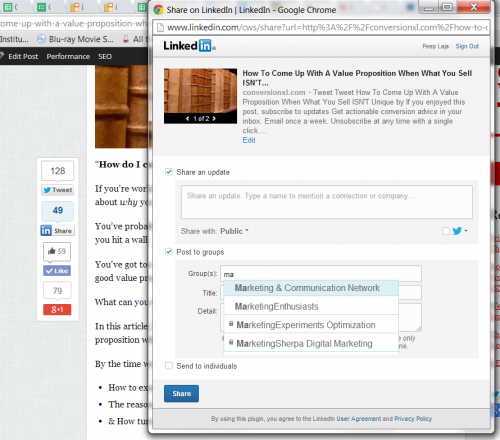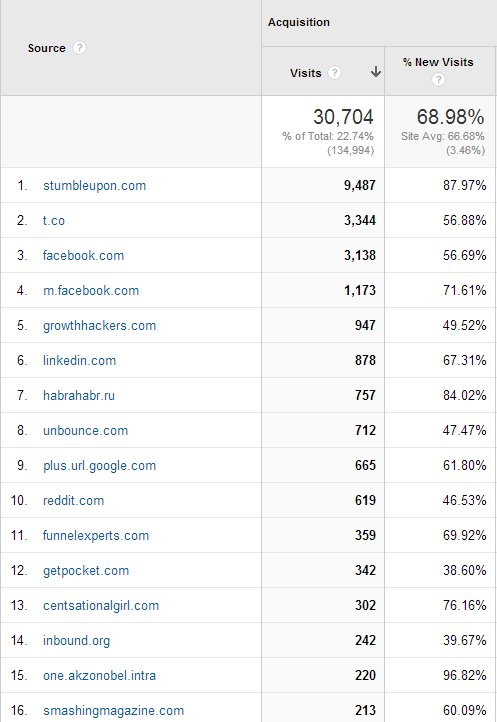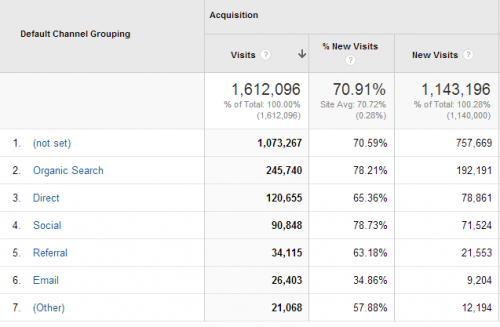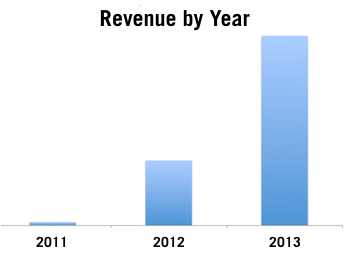How to Get Traffic to Your Blog with 100,000 Visitors in 1 Year
LAST UPDATED ON JULY 30, 2017
Please meet my friend Peep Laja who I met years ago when he created his first failed startup. He subsequently went on to create one of the most popular marketing conversion blogs online. I was curious how he actually did it and wanted him to share the story with you. I’ll let Peep take if from here. -Noah
Enter Peep
I blog over at ConversionXL. It’s a conversion optimization blog, one of the biggest in its market.
I started the blog a little more than 2 years ago (October 2011). While I got 50,000 visits on my first month of blogging thanks to some viral hit posts, the rest of the growth has been slow and steady.
- 15,000 visits on my 3rd month
- 22,000 on my 6th month
- 90,000 on my 10th month
It took a few more months before I started to regularly get 100,000 or more visits each month.
And it’s not just a vanity metric - my blog (indirectly - by generating leads for my business) pays salaries for my staff of 10.
Here's how I went about architecting that growth...
| (Read all the way to the bottom to download the Checklist to Grow Your Own Blog to 100K) |
Content Strategy
Before I got started, I felt unsure about the blogging strategy to pick. There were a gazillion marketing blogs around already. What was the point of yet another marketing blog?
I got over this irrational fear by using data.
Find a gap in the market
My first step was to go through various subjective top “100 marketing blogs” lists (e.g. google “top marketing blogs” or “top fitness blogs” - whatever your niche is), and to analyze the type of content they put out.
I asked questions, lot of questions:
- How many words are in the posts?
- Are they well structured or a wall of text?
- How much data, research and examples are used (vs personal opinions)?
- How many images are used? Are they any good (or is it silly clip art and stupid stock photos)?
- How many external resources are used, linked to?
- Is it useful? Does it contain action-items?
- Is it well-written, interesting to read?
- Legibility: what’s the font size and color (is it easy to read)? Nice typography?
Once I had the answers, I put some thought into how I could be better. How could my content stand out from the noise - both in terms of content and visual presentation?
Since people are not inclined to read much these days - or so I thought - I was expecting to land on a strategy of smart, short posts - summarizing the data, drawing interesting insights from the noise. Kind of like Seth Godin does:

The secret of success is doing something that others are not willing to do for a long, long time.So when I was analyzing the content of marketing blogs - trying to understand how I can be better - I finally figured it out.
The answer? Evidence based, data-driven marketing advice. That was how I summed up the gap in the market. That was going to be my angle.
And I chose to focus specifically on conversion optimization because there were few dedicated CRO blogs around. Picking a niche is important when getting started - don’t be afraid to go niche at first. You can always expand later.
Take Tim Ferriss. Four Hour Workweek. He was that guy. Now he is much more than that, he expanded his brand after the first thing became a success. You can do the same with your blog.
If you start out as a generic marketing blog or fitness blog, it’s very hard to stand out. Ever heard of Nerd Fitness? That’s another great example of going niche in a very crowded market (and finding lots of success).
Know PPC? Don’t start yet another AdWords blog. Instead focus on just the display network.
Using data-backed content made all the difference
If you look at my blog, you won’t find posts that state mere opinions. Or statements like “people generally prefer XYZ”. Instead of claiming “simple websites are better,” I include evidence:
In a study by Google in August of 2012, researchers found that not only will users judge websites as beautiful or not within 1/50th – 1/20th of a second, but also that “visually complex” websites are consistently rated as less beautiful than their simpler counterparts.
Do you see how that adds credibility? It’s not just me saying “simple design is better” anymore.
I have an editorial policy that requires every claim be backed up with research, a case study, or specific example. Now I’m actually pissed whenever I read an article that says “according to research this and that is true” without linking to the actual research. It’s more common than you think — and oh how convenient for the writer to put it in without doing the hard work of finding credible sources.
People love that my posts always contain links to data sources. Most common compliment I hear is“It’s refreshing to see advice that’s backed by actual data”.
Very few blogs do that, and they’re pretty much all successful.
Optimizing posts for traffic
I looked up research on what kind of blog posts get the most social media shares and backlinks.
The most popular posts are:
- Long: Between 1850 to 3035 words (sweet spot being 2700-3000)
- Visual: Posts with videos, images, and lists will attract almost 6 times more links than a plain text post.
So that's what I did:
- I started to write blog posts where every claim is backed up with data
- I made sure they’re at least 1850 words
- I put a lot of effort into the structure of the post: images, subheadlines, lists.
And it worked. And it still works, very well. People are constantly impressed with the quality and depth of the posts. If you write a post that’s around 2000 words or more, you can pack a lot of useful content in it (more content than any 200 word blog post can be).
Will this strategy work for everyone? Probably not. First, you need to be a writer. If you struggle with putting more than two paragraphs together, then 2000+ word articles are not a great match for you. Maybe videos or podcasts are your thing. And maybe there are some great long-form content blogs in your niche already.
If you’re considering starting a blog today, I’d start with research with the goal to have good answers for the following questions:
- What are other blogs in your market / industry / niche doing well?
- What is not being done?
- How can your content be noticeably better and/or different?
You need to find a gap, an opportunity, in order to stand out from the noise.
Getting Visitors
If you’re starting out and you have no pre-existing following, don’t wait until “people find your content on their own” or until “SEO kicks in.” The world doesn’t work that way.
There are obvious things like adding easy social sharing widgets to your blog, so people could spread the word. And using lead magnets to capture emails of readers, so I could later deliver my content to them directly.
I distributed every post I wrote wherever I could.
- I reached out to people and companies mentioned in a post, and many of them shared it on social media
- No begging for retweets (don’t do that)
- My emails / tweets are very short and sweet:“Hey XYZ, Just mentioned you in this blog post: http://www.xyz.com.
Thanks, Peep
ConversionXL”. - I shared my posts on my Twitter, Facebook and LinkedIn account. There’s a nifty thing you can do with LinkedIn - you can mass post to groups that you’re a member of via their sharing widget.

- I submitted every post of mine to Reddit, StumbleUpon, and Hacker News (Inbound.org and GrowthHackers.com weren’t around yet). Some of the posts went viral - like the one I did on pricing experiments and one about techniques for persuading people. Each post took ~18 hours to write, it’s a long-term
investment. I think these 2 were especially successful because they deal with
psychology and irrationality of human behavior. There’s something magical about those topics.
How do you make a post go viral?
Remember this key point: You can only do so much to spread the word about content, the content has to be able to carry its own weight. It needs to be really good, so people say, “This is great shit, I’ll tweet it out!”. What you create needs to be excellent. And then you need see how you can make influential people find it.
A ton of influencers picked up my blog posts from HackerNews. And then Tim Ferriss took my blog down by sending too much traffic.
Funny story about this. My pricing experiments post got to #1 spot in HN during my first month of blogging. Took my blog down (lesson: use a CDN). 7 months later somebody “found” the post again, and posted in on HackerNews, again. I was in the top 10 for 2 days in a row. Massive traffic. And then right after HN traffic had died down, Tim Ferriss shared it on his Facebook account and Twitter.
(Note: I didn’t pitch him, but I’m positive he saw the link on social media
after it went viral via HN.) So this same article has paid me again and again and again. Superb ROI from those 18 hours.
(Note: I didn’t pitch him, but I’m positive he saw the link on social media
after it went viral via HN.) So this same article has paid me again and again and again. Superb ROI from those 18 hours.
Interesting tidbit: while StumbleUpon, Reddit and HN traffic have quite a bad visit-to-email-optin conversion rates, they help in other ways. Stuff that gets popular there gets tweeted out, so I picked up a ton of Twitter followers (easier content distribution later) and got a lot of backlinks as people were sharing interesting links on their blogs. And backlinks + social signals moved the blog up in Google rankings.
•Guest blogging works very well for traffic and audience building. The traffic from those blogs is going to be warm and typically converts extremely well. Word of advice: your guest posts need to be even more epic than the ones you write for your own blog.
Guest posts are essentially high quality advertisements. If you want readers to check out your blog and start following your stuff, you need an epic guest post. Writing epic posts is of course hard work, which is why you should avoid writing for small blogs. The ROI is going to be much smaller if you do that, not worth it.
Don’t be afraid of big blogs. Everyone craves quality content, and they’ll even pay for you. All top blogs pay guest posters (wanna write for me?). SmashingMagazine is still sending me hundreds of visitors each month even after 1.5 years since my last guest post. Last month’s referral traffic stats:

• Content syndication. Business2Community and BusinessInsider want to syndicate your kickass content.
• Say yes to every podcast / webinar opportunity, I did. Every little bit helps to get your name out there. And pitch yourself to be a guest at other people’s podcasts or webinars.
You probably know who are other players in your market, don’t you? If you don’t, ask around on Twitter and spend some time on Google. Identify who has guests on their podcast / webinar, and pitch your topic. If your stuff is good, you’ll get it.
Make sure your blog is packed with quality content before reaching out though. And make sure your pitch contains specific ideas for the topic and why that’s relevant to their audience.
I still hold the all-time record for webinar attendance when I was a guest speaker on Unbounce webinar (Unwebinar). I think it was like 3000+ people. And yes, I got tons of signups to my email lists and still meet people who say “I first heard about you via Unbounce webinar”. Use other people’s audiences to grow yours. But you need to add a ton of value to them, otherwise it won’t work out.
The world is full of mediocre me-toos, and does not need another one. Be so good they can’t ignore you, as Steve Martin once said.
SEO
Sure, SEO helps. But note that I did not utilize an SEO company, I didn’t go out to build a bunch of artificial links. All links to ConversionXL are legit organic links, earned with great content.
Besides using an SEO plugin on my WP, the only SEO I’ve done is to write a post title contains a phrase I might want to rank for. And then I added the same phrase a couple of times into the blog post content as well. That’s it.
I brainstormed a list of keyword phrases (2 words and 3 words long) one might search for when wanting to know about the topic I was about to write about, and used Google AdWords Keyword Planner tool to estimate search volume for each. If the volume was more than 0, I went for it. Long tail ftw. I used to avoid trying to rank for ultra-competitive keywords at first, since I didn’t have the backlinks to outrank others. Now, 2 years later, I
can compete.
can compete.
Organic search is my main traffic driver today:

I haven’t done any paid content promotion at all.
Content Frequency
In my first year I posted 76 posts – that’s one post per 4.8 days. Anyone can do that.
Then I slowed down even more: sometimes even 2 posts per month. “Work” took over. Sometimes I had to remind myself that blogging IS work. Not only have I witnessed that the frequency of posting is correlated with the amount of traffic I get, but also the amount of leads.
Every single time I hit ‘publish’ on a post and email it out to my list, I get a huge jump in incoming leads.
I’m confident my traffic would be higher with more content. And that’s what I’m working on right now.
Have Patience
It’s critical to have patience when starting out. Everyone wants to be an overnight success, but it doesn’t happen. Slow and steady - persistence is key.
I’ve helped many high traffic blogs increase their conversions, and thus have had access to their Google Analytics. I see the same thing *every single time* for their traffic pattern: slow, slow, slow, slow, BOOM!
This is my organic search traffic trend, from the beginning until today:

Plateau. Growth. Plateau. Growth. If you’re wondering what causes the fluctuations between the low and high points are, those are the weekends. And the dip at the end is Christmas, holidays.
Anyways - you gotta keep at it. If you set the expectation that probably not much will happen during the first year, you can keep going without worrying too much about results. You have to persist.
I just saw the same thing mentioned on Derek Halpern’s blog. His revenue over the last 3 years:

If you want to make a quick buck, blogging is not for you. The main purpose of a blog is building an audience. Audience who trusts you, likes you and wants to buy from you - whatever it is that you might be selling today or 4 years from now. And you don’t even need to know what that is - your audience will tell you later.
What’s Next for ConversionXL
My goal is to take it to 1 million monthly readers. I now have a full-time editor on board who helps me with content creation and distribution, guest writer outreach, traffic generation. I’m increasing content frequency and outreach efforts. I still write all the blog posts that are published under my name, unlike many marketing celebrities who use ghostwriters. I believe that authenticity works.
From Noah
Let’s thank Peep for putting together a bad-ass how to guide on creating and actually growing your blog audience. (Did anyone notice how the medium IS the message?)
If you enjoyed the post and learned something 'click to tweet' How to Grow a Blog to 100,000 Visitors in Less than a Year http://ctt.ec/gdhRe+ #OkDork
Check out his very successful web optimization consultancy at ConversionXL
Post a comment below: What is your favorite blog and why?
[Now Closed: Every single OkDork reader who comments will get Peep’s book
How to Build Websites that Sell: The Scientific Approach to Websites for free (normally the already too low price of $5). Giveaway closes Friday 2/14 at midnight Eastern]
How to Build Websites that Sell: The Scientific Approach to Websites for free (normally the already too low price of $5). Giveaway closes Friday 2/14 at midnight Eastern]
Click here to download the Checklist to Grow Your Own Blog to 100K Visitors |
Check out How to Create a Marketing Plan for more.

No comments:
Post a Comment